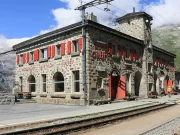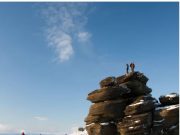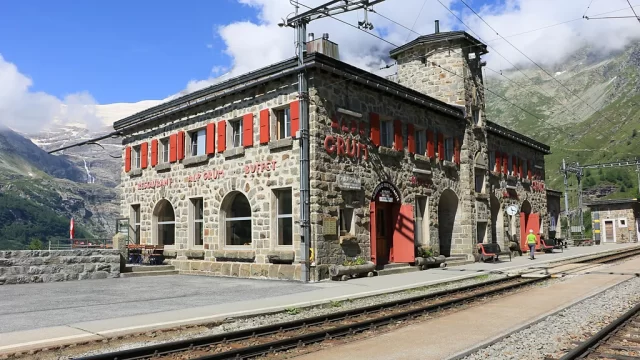While Switzerland is full of Alpine huts and hard-to-reach hotels, Alp Grüm is an anomaly.
“Happily, there are no roads. There is only nature. Sunrises. Sunsets. Stillness. Nothing more, “ Primo Semadeni, the 57-year-old manager of Alp Grüm Hotel in Graubünden, told me as we stood overlooking a high-altitude pass covered in perpetual snow. The soundtrack was whispering wind, singing birds and rushing water as a river tumbled down the valley.
“Look around, we have mountains and glaciers, and we are far from everyday life. It is a challenge but our blessing.”
Hard-to-reach hotels and huts are a Swiss specialty, many of them preserved as monuments to Alpine history. Jungfrau Region, within the snow-ruffled reaches of the Bernese Alps, is for lofty shelters in the car-free villages of Mürren, Wengen, and Kleine Scheidegg, where accommodation can only be accessed by ski lift, cable car, or cogwheel train. These are places of meditation, where hikers wander and the mind slows.
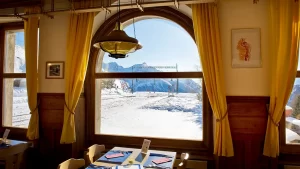 Then there’s an alphabet of dramatic refuges tucked away in mountain eyries, from Appenzell Alps to Zermatt. The best example is the Great St Bernard Hospice in Valais, which demands a long slog on snowshoes in winter, or a high mountain road, that only opens to traffic after the thaw.
Then there’s an alphabet of dramatic refuges tucked away in mountain eyries, from Appenzell Alps to Zermatt. The best example is the Great St Bernard Hospice in Valais, which demands a long slog on snowshoes in winter, or a high mountain road, that only opens to traffic after the thaw.
But Alp Grüm, straddling a razor-edge ridge on the south side of the Bernina Pass at 2,091m, pushes such extremes to the limits. It is caught between languages too, with the immediate north speaking Romansh and the valley below Italian. There is no road to it beneath Piz Bernina, the highest peak of the Eastern Alps. And the only way to get there year-round is either to hike in for hours – not recommended in winter – or to take the Rhaetian Railway that climbs high between the little towns of Pontresina and Poschiavo near the Italian border.
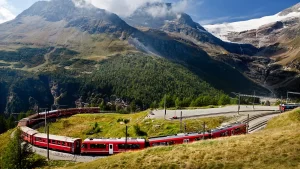 What’s more, the hotel’s identity is wholly drawn from the history of the rail company, and it doubles as a train station, platform, and waiting room. Between 20:00 and 08:00, however, the trains leave the rails and the hotel is cut off from the rest of Switzerland, left to exist in a bubble of its own. The Alps can so often feel like one has stepped into a storybook, but nowhere quite as strongly as in the Engadin valley, whose horizon is a lithograph of great mountains that crest like waves. I’ve been to the area many times to measure my experience of Switzerland at its wildest against that of the pioneers of winter sports tourism-but this time I was in comfort, on board the Bernina Express and traveling south from Chur, the oldest town in Switzerland.
What’s more, the hotel’s identity is wholly drawn from the history of the rail company, and it doubles as a train station, platform, and waiting room. Between 20:00 and 08:00, however, the trains leave the rails and the hotel is cut off from the rest of Switzerland, left to exist in a bubble of its own. The Alps can so often feel like one has stepped into a storybook, but nowhere quite as strongly as in the Engadin valley, whose horizon is a lithograph of great mountains that crest like waves. I’ve been to the area many times to measure my experience of Switzerland at its wildest against that of the pioneers of winter sports tourism-but this time I was in comfort, on board the Bernina Express and traveling south from Chur, the oldest town in Switzerland.
Alp Grüm’s story in pictures began in 1906 when the farsighted rail company Bernina-Bahngesellschaft announced an ambitious plan for an electrified train that would link Switzerland with Italy beneath a roll and tumble of mountains and glaciers. What made the proposition so amazing was that it would become the Alps’ highest rail crossing, prising open the area to tourists but also slashing travel time for traders; back then, it took horse-riding messengers nine hours to make the dangerous journey between Samedan and Tirano. That struggle was compounded in winter, with the threat of avalanches and the possibility of becoming stranded by heavy snowfall.
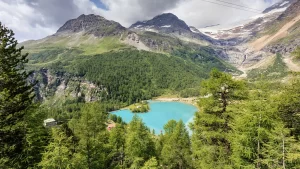 To say Switzerland did not have precedence for this sort of engineering project would be to understate it. Thirty years prior in 1888, Dutch hotelier Willem Jan Holsboer founded the nearby Landquart-Davos narrow-gauge railway. The town of Davos is best known for the World Economic Forum, but its roots are as a spa town and Holsboer capitalized by way of bringing more visitors to the resort than the horse-drawn carriages did. No less of a marvel before that was the opening of the Gotthard Railway from Immensee to Chiasso in 1882 featuring what was then the world’s longest rail tunnel.
To say Switzerland did not have precedence for this sort of engineering project would be to understate it. Thirty years prior in 1888, Dutch hotelier Willem Jan Holsboer founded the nearby Landquart-Davos narrow-gauge railway. The town of Davos is best known for the World Economic Forum, but its roots are as a spa town and Holsboer capitalized by way of bringing more visitors to the resort than the horse-drawn carriages did. No less of a marvel before that was the opening of the Gotthard Railway from Immensee to Chiasso in 1882 featuring what was then the world’s longest rail tunnel.
It was against this background, on a sunny day in July 1910, that the Bernina Line was opened and Alp Grüm began life – not as a stone-built, 10-room hotel and waiting room as it is today, but as a timber cabin, from where the station chief could check the line every morning.
The Bernina Line was taken over by Rhaetian Railway in 1943, and the concept of it, as Company spokesperson Camille Härdi describes, was a mere “rest stop,” a notion none can barely believe today. “The Bernina Line wasn’t even originally supposed to operate all year round,” Härdi said. “However, the railway’s management board decided in 1910- once the line to Tirano had been finished acquire a snow plow. It first came into use in the winter of 1910/11 and proved to be a wondrous piece of technology, capable of cutting the considerable costs normally associated with snow-clearing.”
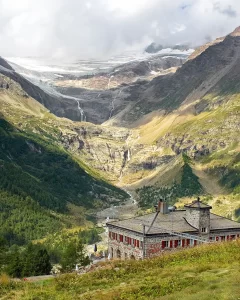 These days, the Bernina Line rarely, if ever, closes, meaning Alp Grüm is no longer the Shangri-La it once was. “Winter has changed over the years with the glaciers receding and global warming,” said Härdi. “Even so, it still happens there is plenty of snow. There’s a locomotive called a ‘Snow Blower’ that makes sure the train runs even after a heavy snowfall.” But enough of that original urge to build Alp Grüm has survived: The geometry of glaciers and lakes still stands implacably stunning; I was immediately entranced upon arrival by the Palü Glacier and its terminal lake, Lago Palü.
These days, the Bernina Line rarely, if ever, closes, meaning Alp Grüm is no longer the Shangri-La it once was. “Winter has changed over the years with the glaciers receding and global warming,” said Härdi. “Even so, it still happens there is plenty of snow. There’s a locomotive called a ‘Snow Blower’ that makes sure the train runs even after a heavy snowfall.” But enough of that original urge to build Alp Grüm has survived: The geometry of glaciers and lakes still stands implacably stunning; I was immediately entranced upon arrival by the Palü Glacier and its terminal lake, Lago Palü.
Above was Ospizio Bernina, the Alps’ highest rail crossing at 2,253m. Far below, looking down towards Valposchiavo, the serpentine curve of the tracks switch-backed down a steeply pitched slope. Foregrounding that, the station, remodeled in stone in 1923, was gloriously isolated. It had the air of an Italian villa transferred to a mountaintop, with pizzoccheri .













